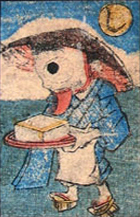Hitotsume-kozō
This article needs additional citations for verification. (November 2011) |

Hitotsume-kozō (一つ目小僧, "one-eyed boys")[citation needed] are obake found in Japanese folklore.[citation needed]
Description
Hitotsume-kozō are roughly "the size of ten-year-old children,"[citation needed] but otherwise "resemble bald Buddhist monks."[citation needed] Their most distinctive feature, however, is a "single, giant eye peering from the center of the face, along with a long tongue, much like a Tsukomogami."[citation needed]
Hitotsume-kozō are relatively harmless creatures,[citation needed] content to "run about frightening people or telling loud people to be quiet."[citation needed]
Since many people consider an encounter with a [Hitotsume-kozō] to be a bad omen ... often [they] leave bamboo baskets in front of their houses, as these are reputed to repel the creatures. A reason for this may be that, in seeing the basket's many holes, the Hitotsume-kozō will see the basket as having many eyes, and run away jealous and ashamed at only having one.[citation needed]
Sources
- The Obakemono Project (citing sources)
